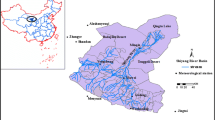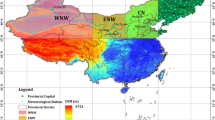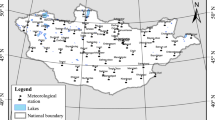Abstract
The Loess Plateau, the transitional zone between humid and arid regions of China, is an important region to examine the regional hydrological cycle and variation in humid and arid regions under global climate change. Aridity index (AI), the ratio of precipitation (P) to potential evapotranspiration (ET0), is an important indicator of regional climate conditions and is also used to classify drylands. In this study, data from 51 national meteorological stations during the period of 1961–2014 were collected to estimate the AI in the Loess Plateau. Results show that a downward trend in annual AI was detected and the boundary of the drylands region based on the AI was expanded across the Loess Plateau over the period of 1961–2014. The spatiotemporal variability of P was the main cause in the AI variations. Furthermore, data analysis suggested the occurrences of the extreme minimum AI values were mostly affected by fluctuations of the two factors (ET0 and P) rather than its corresponding trend during the period. Thus, this study indicated the major driving factor of AI and the relationship between extreme AI values and the global climate anomalies in the Loess Plateau region, and meanwhile, provided an understanding of the impacts of climate change on hydrological cycle in the Loess Plateau of China.









Similar content being viewed by others
References
Allen RG, Pereira LS, Raes D, Smith M (1998) Crop evapotranspiration—guidelines for computing crop water requirements—FAO irrigation and drainage paper 56. FAO, Rome
Fu G, Chen S, Liu C, Shepard D (2004) Hydro-climatic trends of the Yellow River basin for the last 50 years. Clim Change 65(1–2):149–178
Fyfe JC, Meehl GA, England MH, Mann ME, Santer BD, Flato GM, Hawkins Ed, Gillett NP, Xie SP, Kosaka Y, Swart NC (2016) Making sense of the early-2000s warming slowdown. Nat Clim Change 6(3):224–228
General US (1994) United Nations convention to combat drought and desertification in countries experiencing serious droughts and/or desertification, particularly in Africa. Particularly in Africa
Gong L, C-y Xu, Chen D, Halldin S, Chen YD (2006) Sensitivity of the Penman–Monteith reference evapotranspiration to key climatic variables in the Changjiang (Yangtze River) basin. J Hydrol 329(3–4):620–629. https://doi.org/10.1016/j.jhydrol.2006.03.027
Hargreaves GH, Samani ZA (1985) Reference crop evapotranspiration from temperature. Appl Eng Agric 1(2):96–99
Huang J, Yu H, Guan X, Wang G, Guo R (2015) Accelerated dryland expansion under climate change. Nat Clim Change 6(2):166–171. https://doi.org/10.1038/nclimate2837
Huang J, Ji M, Xie Y, Wang S, He Y, Ran J (2016) Global semi-arid climate change over last 60 years. Clim Dyn 46(3–4):1131–1150
Huo Z, Dai X, Feng S, Kang S, Huang G (2013) Effect of climate change on reference evapotranspiration and aridity index in arid region of China. J Hydrol 492:24–34
IPCC (2007) Summary for policymakers. In: Solomon S, Qin D, Manning M, Chen Z, Marquis M, Averyt KB, Tignor M, Miller HL (eds) Climate change 2007: the physical science basis. Cambridge University Press, New York
Jahanbani H, Shui LT, Bavani AM, Ghazali AH (2011) Uncertainty of climate change and its impact on reference evapotranspiration in Rasht City, Iran. J Water Clim Change 2(1):72–83
Kendall MG (1975) Rank correlation methods. Charles Griffin, London
Le Houérou HN (1996) Climate change, drought and desertification. J Arid Environ 34(2):133–185
Li P, Qian H, Wu J (2014) Accelerate research on land creation. Nature 510(7503):29–31. https://doi.org/10.1038/510029a
Li Y, Huang J, Ji M, Ran J (2015a) Dryland expansion in northern China from 1948 to 2008. Adv Atmos Sci 32(6):870–876
Li P, Qian H, Howard KWF, Wu J (2015b) Building a new and sustainable “Silk Road economic belt”. Environ Earth Sci 74(10):7267–7270. https://doi.org/10.1007/s12665-015-4739-2
Liu Q, McVicar TR (2012) Assessing climate change induced modification of Penman potential evaporation and runoff sensitivity in a large water-limited basin. J Hydrol 464–465:352–362. https://doi.org/10.1016/j.jhydrol.2012.07.032
Liu Q, Yang Z, Cui B, Sun T (2010) The temporal trends of reference evapotranspiration and its sensitivity to key meteorological variables in the Yellow River Basin, China. Hydrol Process 24(15):2171–2181
Mann HB (1945) Nonparametric test against trend. Econometrica 13:245–259
McCuen RH (1974) A sensitivity and error analysis cf procedures used for estimating evaporation. JAWRA J Am Water Resour Assoc 10(3):486–497
Middleton N, Thomas D (1997) World atlas of desertification. Geogr J 160(2):325
Papaioannou G, Kitsara G, Athanasatos S (2011) Impact of global dimming and brightening on reference evapotranspiration in Greece. J Geophys Res Atmos 116(D9):D9107
Peng H, Cheng G, Xu Z, Yin Y, Xu W (2007) Social, economic, and ecological impacts of the “Grain for Green” project in China: a preliminary case in Zhangye, Northwest China. J Environ Manage 85(3):774–784
Qian H, Li P, Wu J (2010) Analysis on characteristics of precipitation variation over the past 49 years in Yinchuan City of China. J North China Inst Water Conserv Hydroelectr Power 31(2):1–5 (in Chinese)
Sun F, Roderick ML, Farquhar GD (2012) Changes in the variability of global land precipitation. Geophys Res Lett 39(19):19402. https://doi.org/10.1029/2012GL053369
Thornthwaite CW (1948) An approach toward a rational classification of climate. Geogr Rev 38(1):55–94
Todisco F, Vergni L (2008) Climatic changes in Central Italy and their potential effects on corn water consumption. Agric For Meteorol 148(1):1–11
UNCCD (1994) United Nations convention to combat desertification in countries experiencing serious drought and/or desertification, particularly in Africa. Permanent Secretariat UNCCD, Bonn. http://www.unccd.int/
Voepel H, Ruddell B, Schumer R, Troch P, Brooks P, Neal A, Durcik M, Sivapalan M (2011) Quantifying the role of climate and landscape characteristics on hydrologic partitioning and vegetation response. Water Resour Res 47(10):427–438
Wang G, Wu B, Wang ZY (2005) Sedimentation problems and management strategies of Sanmenxia Reservoir, Yellow River, China. Water Resour Res 4(9):W09417
Wu J, Li P, Qian H (2013) Variation characteristics of meteorological elements and prediction model of available precipitation in Xi’an City. South-to-North Water Transf Water Sci Technol 11(1):50–54. https://doi.org/10.3724/SP.J.1201.2013.31050 (in Chinese)
Wu J, Qian H, Li P, Song Y (2014) A system-theory-based model for monthly river runoff forecasting: model calibration and optimization. J Hydrol Hydromech 62(1):82–88. https://doi.org/10.2478/johh-2014-0006
Xu JX (2003) A study of sediment delivery by floods in the lower Yellow River, China. Hydrol Sci J Sci Hydrol 48:553–566
Xu C, Gong L, Jiang T, Chen D, Singh VP (2006) Analysis of spatial distribution and temporal trend of reference evapotranspiration and pan evaporation in Changjiang (Yangtze River) catchment. J Hydrol 327(1):81–93
Yue S, Pilon P, Cavadias G (2002) Power of the Mann–Kendall and Spearman’s rho tests for detecting monotonic trends in hydrological series. J Hydrol 259(1):254–271
Zhang Q, Xu CY, Zhang Z (2009) Observed changes of drought/wetness episodes in the Pearl River basin, China, using the standardized precipitation index and aridity index. Theor Appl Climatol 98(1–2):89–99
Zhang B, He C, Burnham M, Zhang L (2016) Evaluating the coupling effects of climate aridity and vegetation restoration on soil erosion over the Loess Plateau in China. Sci Total Environ 539:436–449
Zhang K, Pan S, Zhang W, Xu Y, Cao L, Hao Y, Wang Y (2015) Influence of climate change on reference evapotranspiration and aridity index and their temporal-spatial variations in the Yellow River Basin, China, from 1961 to 2012. Quat Int 380–381:75–82
Zhao Y, Zou X, Zhang J, Cao L, Xu X, Zhang K, Chen Y (2014) Spatio-temporal variation of reference evapotranspiration and aridity index in the Loess Plateau Region of China, during 1961–2012. Quat Int 349:196–206
Acknowledgements
This study was supported by the National Natural Science Foundation of China (Grant Nos. 51379175 and 51679200), the Program for Key Science and Technology Innovation Team in Shaanxi Province (Grant No. 2014KCT-27), and the Hundred Talents Project of the Chinese Academy of Sciences (Grant No. A315021406). The authors declare that there is no conflict of interest regarding the publication of this paper.
Author information
Authors and Affiliations
Corresponding author
Additional information
This article is a part of a Topical Collection in Environmental Earth Sciences on Water resources development and protection in loess areas of the world, edited by Drs. Peiyue Li and Hui Qian.
Rights and permissions
About this article
Cite this article
Wen, M., Cheng, D., Song, J. et al. Impacts of climate change on aridity index and its spatiotemporal variation in the Loess Plateau of China, from 1961 to 2014. Environ Earth Sci 77, 137 (2018). https://doi.org/10.1007/s12665-018-7304-y
Received:
Accepted:
Published:
DOI: https://doi.org/10.1007/s12665-018-7304-y




